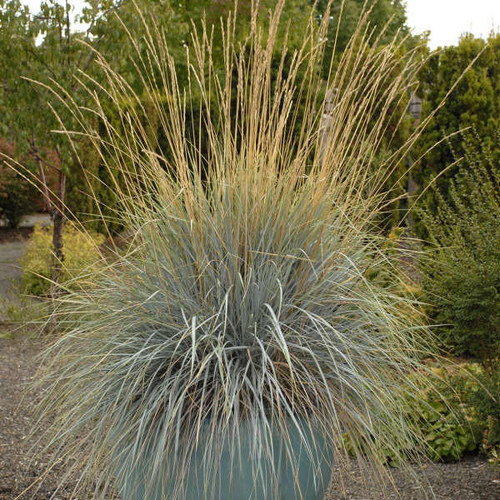Product Description
Helictotrichon sempervirens (25) Bare Root Plants
Common name: Grass-Ornamental, Blue Oat Grass.
Blue Oat grass looks like a miniature water fountain, with its densely packed leaves gently spraying upward and arching back downward at the tips. This species displays spiky, blue-gray foliage that will draw your attention all season long.
In early summer, small, tan seed heads appear on tall stems held well above the foliage. In mild climates, this grass is evergreen; it is semi-evergreen in colder zones.
Blue Oat Grass adds a wonderful coarse element to rock gardens, coastal gardens, or dry hillsides.
The best place to plant Helictotrichon is a dry, sunny site. Once established, it will not require supplemental watering unless there is a drought. Trim back the old foliage to 3-4" in spring before the new growth emerges. Division is recommended every 3-4 years in spring to keep the plant looking fresh.
Royal Horticultural Society's Award of Garden Merit -- 1993
Height: 24.0-30.0 Inches
Spread: 24.0-30.0 Inches
Hardiness Zones: 3,4,5,6,7,8
Flower Color: Tan shades
Foliage Color: Blue shades
Full Sun (> 6 hrs. Direct Sun)
Low Water Needs
Average to Fertile Soil Quality
Bloomtime: Early Summer
Seasonal Interest: Dried Seed Heads, Fall Color
Evergreen
Growth Rate: Medium
Border Plant, Container, Dried Flower, Drought Tolerant, Attractive Foliage, Mass Planting, Salt Tolerant, Specimen
Other Details
The most important part of the plant is its root system. Healthy roots are the foundation of a healthy, vibrant plant. The type of plug container used is based on the specific needs of the plants. Perennials offered as bare root traditionally perform better when planted as bare root.Planted in a specialized mix, potted plants have well established root systems. Top growth stage will vary depending on the current life cycle and time of year when shipped. In Winter and early Spring dormant plants may be shipped. Dormant plants may be planted right away, even before the last frost date.
Most bare root varieties are field grown for at least one season, though Hemerocallis and Hosta are grown for two seasons. The bulk of the soil is removed during the harvesting process and the tops of most varieties are trimmed back to the crown. They are graded, packed in shredded aspen or sphagnum moss and stored in freezers until ready to be shipped.
See our Container Sizes and Bare Root Perennials pages for more information.
Plant information and care is provided in the Overview section, Plant Genus Page and general information is provided in the Planting Care & Guides. Additional questions can be asked on each Plant page.
Plant Spacing: Using the maximum mature spread or width of a plant to guide spacing, ensures space to grow to full size. To fill an area sooner, plant them closer together. Just remember, future thinning or transplanting may be needed.
Water: Keep a close eye on newly planted perennials, especially throughout the first growing year. Most early plant loss is due to too much or too little water!























